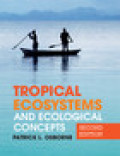
Introductory textbook using the entire range of tropical ecosystems - terrestrial, freshwater and marine - to illustrate and explain major ecological concepts. This introductory textbook covers the entire range of tropical ecosystems – terrestrial, freshwater and marine – and uses each system to illustrate and explain major ecological concepts, including primary and secondary production, population dynamics and community ecology. The impact of human activity, and climate change in particular, is highlighted throughout. This introductory textbook covers the entire range of tropical ecosystems – terrestrial, freshwater and marine – and uses each system to illustrate and explain major ecological concepts, including primary and secondary production, population dynamics and community ecology. The impact of human activity, and climate changein particular, is highlighted throughout. Tropical habitats cover over one third of the Earth's terrestrial surface and harbor much of its biodiversity, with many areas rich in endemic species. However, these ecosystems are under significant and growing threat from issues such as deforestation, land degradation and ocean acidification. This introductory textbook provides a comprehensiveguide to the major tropical biomes. It is unique in its balanced coverage of both aquatic and terrestrial systems and in its international scope. Each chapter is built around a particular tropical ecosystem, with descriptive case studies providing a framework around which ecological concepts and applied ecological topics are presented. This second edition has been thoroughly updated to reflect recent advances in the field and includes a greater focus on the impact of global climate change. The text is supported throughout by boxes containing supplementary material and is illustrated with over 200 clear, simple line diagrams, maps and photographs. INDICE: Preface; Abbreviations and units; 1. The tropical environment and climate; 2. Dry, hot deserts and environmental factors; 3. Grasslands and primary production; 4. Savanna and population dynamics; 5. Lakes, energy flow and biogeochemical cycling; 6. Rivers, floodplains and estuaries: the river continuum and flood-pulse concepts; 7. Wetlands and succession; 8. Tropical rain forests and biodiversity; 9. Mountains, zonation and community gradients; 10. Mangroves, seagrasses and decomposition; 11. Coral reefs and community ecology; 12. Islands, archipelagos, biogeography and evolutionary ecology; 13. Cities and human ecology; Glossary; References; Index.
- ISBN: 978-0-521-17734-4
- Editorial: Cambridge University
- Encuadernacion: Rústica
- Páginas: 536
- Fecha Publicación: 09/02/2012
- Nº Volúmenes: 1
- Idioma: Inglés
